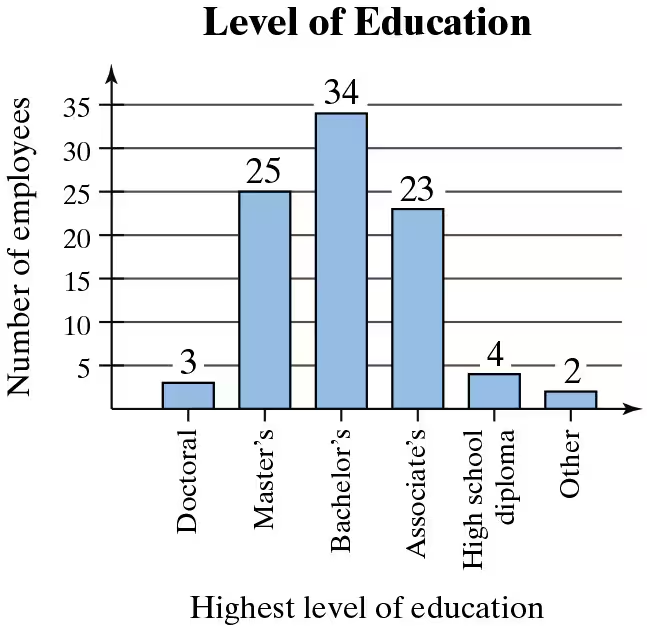Table of contents
- 1. Intro to Stats and Collecting Data55m
- 2. Describing Data with Tables and Graphs1h 55m
- 3. Describing Data Numerically1h 45m
- 4. Probability2h 16m
- 5. Binomial Distribution & Discrete Random Variables2h 33m
- 6. Normal Distribution and Continuous Random Variables1h 38m
- 7. Sampling Distributions & Confidence Intervals: Mean1h 3m
- 8. Sampling Distributions & Confidence Intervals: Proportion1h 12m
- 9. Hypothesis Testing for One Sample1h 1m
- 10. Hypothesis Testing for Two Samples2h 8m
- 11. Correlation48m
- 12. Regression1h 4m
- 13. Chi-Square Tests & Goodness of Fit1h 20m
- 14. ANOVA1h 0m
4. Probability
Basic Concepts of Probability
Problem 3.1.77
Textbook Question
Using a Bar Graph to Find Probabilities In Exercises 75-78, use the bar graph at the left, which shows the highest level of education received by employees of a company. Find the probability that the highest level of education for an employee chosen at random is
77. a master's degree.

 Verified step by step guidance
Verified step by step guidance1
Step 1: Identify the total number of employees in the company by summing the frequencies of all education levels shown in the bar graph. Add the values: 3 (Doctoral) + 25 (Master's) + 34 (Bachelor's) + 23 (Associate's) + 4 (High school diploma) + 2 (Other).
Step 2: Determine the number of employees whose highest level of education is a master's degree. From the bar graph, this value is 25.
Step 3: Calculate the probability of randomly selecting an employee whose highest level of education is a master's degree. Use the formula for probability: \( P = \frac{\text{Number of favorable outcomes}}{\text{Total number of outcomes}} \). Substitute the values: \( P = \frac{25}{\text{Total number of employees}} \).
Step 4: Simplify the fraction obtained in Step 3, if necessary, to express the probability in its simplest form.
Step 5: Interpret the result as the likelihood of randomly selecting an employee with a master's degree, ensuring the probability is expressed as a fraction, decimal, or percentage depending on the context.
 Verified video answer for a similar problem:
Verified video answer for a similar problem:This video solution was recommended by our tutors as helpful for the problem above
Video duration:
1mPlay a video:
Was this helpful?

 5:37m
5:37mWatch next
Master Introduction to Probability with a bite sized video explanation from Patrick
Start learningRelated Videos
Related Practice

